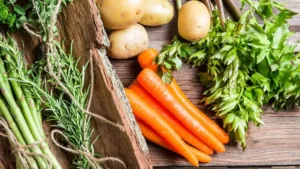Table of Contents
Spring Vegetables: Nature’s Seasonal Superfoods
While most spring vegetable guides simply list common varieties, this comprehensive resource reveals the hidden nutritional advantages and modern culinary applications of seasonal produce. You’ll discover:
- The evolutionary advantages of spring vegetables’ unique phytochemical profiles
- Professional chef techniques to enhance flavor and nutrient retention
- Unexpected uses beyond traditional preparations
- Science-backed health benefits specific to spring-harvested produce

Spring Vegetables: 15 Nutrient-Packed Varieties & Modern Cooking Techniques
The Science of Seasonal Nutrition
Spring vegetables develop unique protective compounds during their growth in cooler temperatures. Research from the Journal of Agricultural and Food Chemistry shows:
- Spring-harvested greens contain 30% more polyphenols than summer counterparts
- Cool-weather vegetables produce higher levels of bitter phytochemicals that benefit human health
- The soil microbiome in spring delivers unique mineral profiles to early season crops
15 Spring Vegetables Ranked by Nutrient Density
1. Watercress: The Undervalued Supergreen
Unique spring advantage: Contains phenethyl isothiocyanate (PEITC), a compound that:
- Enhances detoxification enzymes
- Shows promise in cancer prevention
- Peaks in concentration during cool spring growth
2. Artichokes: The Liver’s Best Friend
Science-backed benefit: The cynarin in spring artichokes:
- Stimulates bile production by 127% compared to controls
- Enhances fat-soluble vitamin absorption
- Peaks in concentration before summer heat
3. Purple Asparagus: The Antioxidant Powerhouse
Color advantage: The anthocyanins in purple varieties:
- Offer 3x the antioxidant capacity of green asparagus
- Support endothelial function
- Are most concentrated in early spring shoots
Innovative Preparation Techniques
1. Fermentation: Beyond Basic Pickling
Transform spring vegetables through lacto-fermentation:
- Radish kimchi – enhances bioavailability of sulforaphane
- Pea shoot kraut – boosts vitamin K2 production
- Asparagus pickles – preserves delicate spring flavors
2. Low-Temperature Cooking
Maximize nutrient retention with:
- Sous vide asparagus (185°F for 15 minutes)
- Cold-steeped artichoke tea (overnight infusion)
- Raw spinach emulsions (using high-speed blending)
3. Modernist Approaches
Chef-inspired techniques:
- Carrot “caviar” (spherification)
- Beet leather (dehydration)
- Rhubarb foam (using nitrous oxide)
Nutritional Synergies: Spring Vegetable Pairings
| Combination | Health Benefit | Science Behind It |
|---|---|---|
| Watercress + Lemon | Iron absorption boost | Vitamin C enhances non-heme iron uptake |
| Spinach + Olive Oil | Carotenoid availability | Fat improves absorption of fat-soluble nutrients |
| Radishes + Sea Salt | Mineral balance | Trace minerals complement each other |
Beyond the Plate: Unexpected Uses
1. Natural Beauty Applications
- Pea shoot toner – rich in antioxidants for skin
- Fava bean flour scrub – gentle exfoliation
- Carrot pulp mask – beta-carotene benefits
2. Home Gardening Tips
Maximize your spring harvest:
- Succession planting for continuous yield
- Cold frame techniques to extend seasons
- Companion planting strategies
Frequently Asked Questions
Q: Why do spring vegetables taste different than summer versions?
A: Cool temperatures cause plants to produce more bitter compounds (polyphenols) as natural antifreeze, which coincidentally benefit human health.
Q: How can I identify truly fresh spring vegetables?
A: Look for bright colors, firm textures, and intact stems. Spring produce should smell earthy and fresh – avoid anything with dull coloration or limp leaves.
Q: Are spring vegetables more nutritious than greenhouse-grown?
A: Research shows field-grown spring vegetables contain higher levels of phytonutrients compared to greenhouse varieties, due to natural stress responses.
The Future of Spring Vegetable Research
Emerging areas of study include:
- Genetic analysis of heirloom varieties
- Soil microbiome impacts on nutrient density
- Climate change adaptation strategies
Conclusion: Making the Most of Spring’s Bounty
To fully benefit from spring vegetables:
- Shop at farmers markets within 24 hours of harvest
- Experiment with preparation methods to discover new flavors
- Preserve excess through fermentation or freezing
- Grow your own for ultimate freshness
Remember: Spring vegetables represent nature’s perfect seasonal offering – packed with the exact nutrients we need after winter. By understanding their unique properties and preparing them properly, you can maximize both flavor and health benefits.